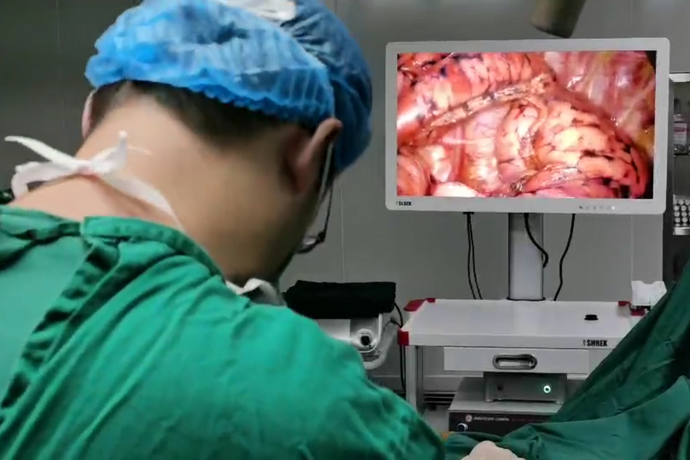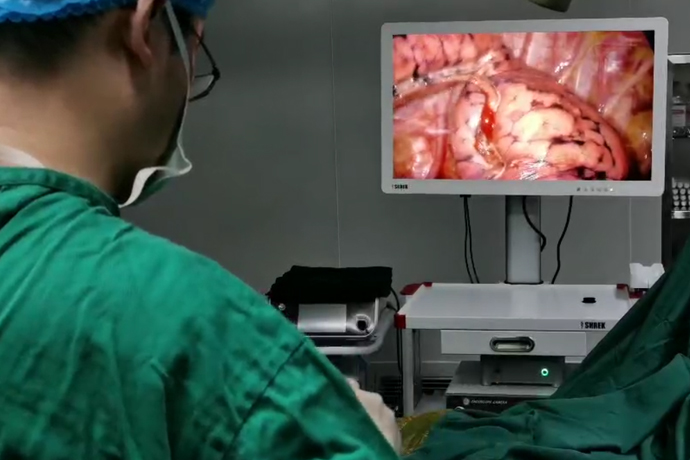[Thoracoscopic surgery of thoracic surgery] 4K ultra-high definition thoracoscopy for radical resection of lung cancer
Release time: 28 Nov 2023 Author:Shrek
Lung cancer is one of the malignant tumors with the fastest growing morbidity and mortality and the greatest threat to human health and life. Lung cancer is one of the most common clinical malignant tumors, and its mortality rate ranks first among all tumors. The preferred method of treatment for lung cancer is comprehensive treatment based on surgery. Traditional surgery is an incision with a length of about 30-40 centimeters. Two layers of the patient's chest and back and four large muscle groups that control the movement of the shoulder joints and chest and back are cut off. Using a rib retractor to support a large enough space results in serious surgical trauma and many complications. Postoperative surgery is often accompanied by long-term chest pain, mobility impairment of the upper limb on the surgical side, and even affects daily life such as combing hair and washing face.

With the continuous breakthroughs in medical technology, traditional invasive thoracotomy surgery has become minimally invasive thoracoscopic surgery. Minimally invasive thoracoscopy technology shortens the operating incision to about 8-10 cm, and with 2-3 auxiliary holes, the chest and back muscles and ribs are not cut, and the trauma is reduced.
Classification of lung cancer
Divided by part: central type, peripheral type
According to biology:
√Small cell lung cancer: (15-20%)
√Non-small cell lung cancer: (80-85%)
Squamous cell carcinoma Adenocarcinoma Large cell carcinoma
Adenosquamous carcinoma
Other
Indications
Radical surgery for lung cancer
That is, radical surgery for lung cancer requires removal of the lung tissue where the lung tumor is located and systematic lymph node dissection to try to avoid the recurrence of lung cancer.
Surgical steps
1. Disinfect skin and spread drapes
2. Connect equipment, instruments and other devices
3. Identify the intercostal space and place the chest cannula
4. Separation of pleural adhesions
5. Free the part of the lung that needs to be removed, separate, ligate, cut off the pulmonary blood vessels, and remove the lesions
6. Treatment of bronchus
7. Chest lymph node dissection
8. Check the stump lung, stop bleeding, and place chest drainage tube
9. Close the incision
Postoperative precautions
1. Avoid eating spicy, irritating and overly greasy food, develop good personal habits, and quit smoking and drinking, which will be beneficial to postoperative recovery.
2. Eat more nutritious and protein-rich foods to maintain nutritional balance. Eat more easily digestible foods to help absorb protein and nutrients.
3. Eating more fresh vegetables, fruits and foods that can clean the lungs is beneficial to postoperative recovery. Also change bad cooking habits. Because people who cook frequently have twice the incidence of lung cancer than people who don't cook often.
4. Regularly supplement some vitamin C and drink more warm water to enhance resistance.
5. Carry out periodic physical exercise to prevent the occurrence of other diseases.

- Recommended news
- 【General Surgery Laparoscopy】Cholecystectomy
- Surgery Steps of Hysteroscopy for Intrauterine Adhesion
- [Gynecological Hysteroscopy] Techniques for Preventing and Treating Complications of Hysteroscopic Surgery
- [Gynecological Hysteroscopy] Hysteroscopic Adhesiolysis
- [Gynecological Hysteroscopy] IUD Removal under Hysteroscopy